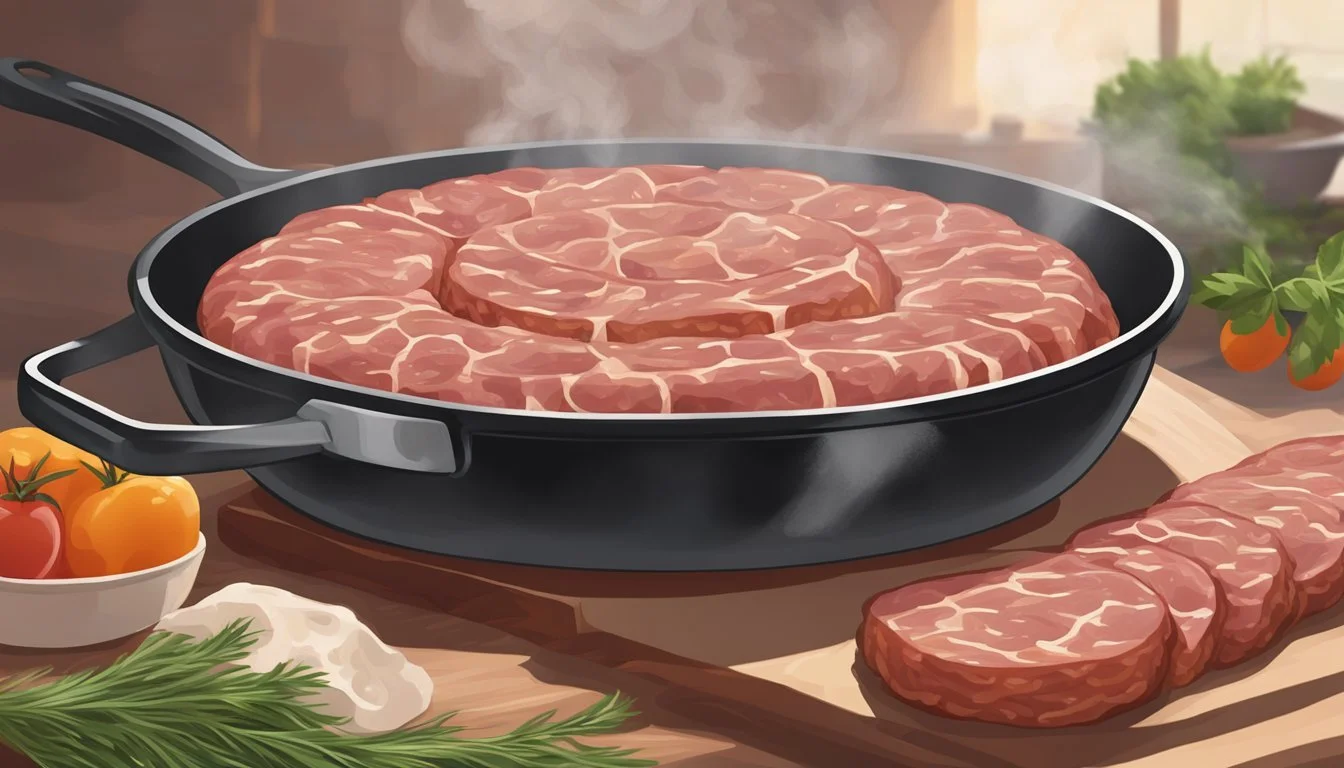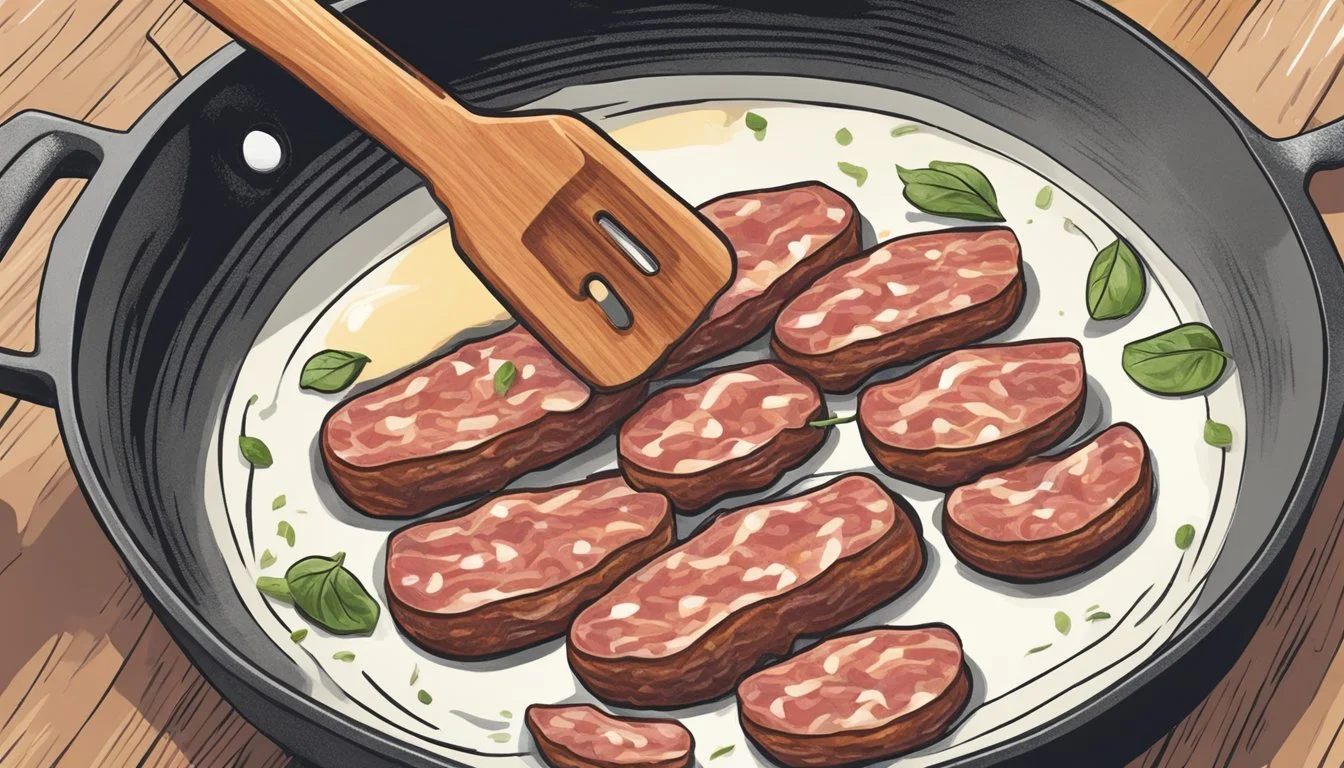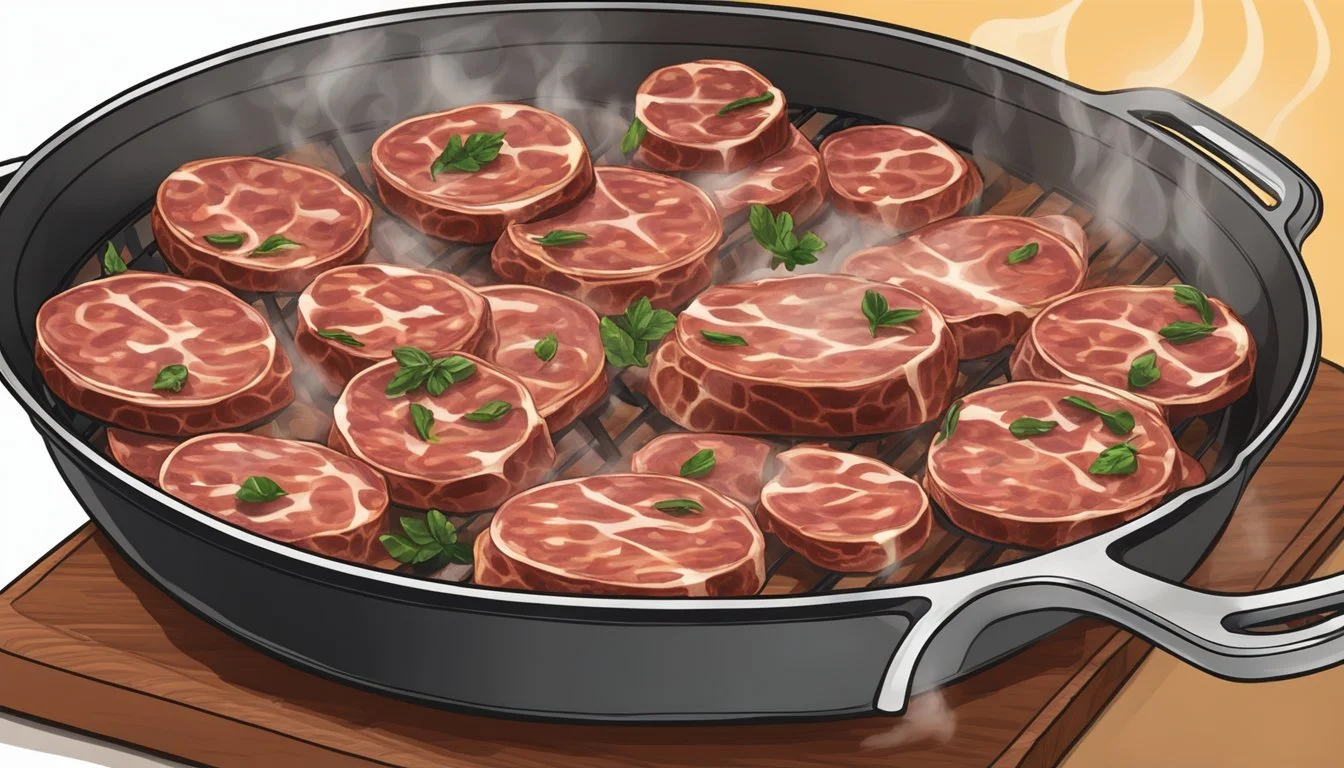Best Way to Reheat Soppressata
Ensuring Flavor and Tenderness
Soppressata is an Italian dry-cured salami, known for its robust flavor and firm texture. A delicacy often served at room temperature to accentuate its taste, it occasionally calls for reheating, especially when incorporated into cooked dishes. The challenge in reheating soppressata lies in retaining its distinctive flavors and succulence, which can be compromised if not approached correctly.
Understanding the properties of soppressata is key to reheating it without diminishing its quality. As a dry-cured meat, soppressata contains less moisture than fresh sausages, making it prone to toughening when exposed to high heat for extended periods. Thus, gentle reheating methods are preferred to avoid degrading the texture and to ensure the soppressata emerges just as enjoyable as it was originally served.
Understanding Soppressata
Soppressata is an Italian dry-cured salami known for its robust flavor and versatility in dishes. It's essential to grasp the types, ideal serving temperatures, and the texture to appreciate its culinary value fully.
Types of Soppressata
There are several regional variations of Soppressata, each with its unique preparation and taste. The most notable difference lies in the meat used; while some are made with beef, others primarily consist of pork. Varieties such as Soppressata di Calabria and Soppressata di Basilicata have their distinct characteristics, often spiced and with varying degrees of fat content.
Ideal Consumption Temperature
When consuming Soppressata, it’s traditionally served at room temperature to best appreciate its flavors. Heating the meat can release its aromatic oils, deepening the flavor profile. If one is reheating Soppressata, the goal is to warm it gently without cooking it further, as overcooking could lead to a loss of its natural juices, transforming its tender textures into something firmer and drier.
Soppressata's Texture and Moisture
The texture of Soppressata can range from firm to slightly chewy, with connective tissue contributing to its mouthfeel. The dry-curing process aims to reduce moisture, concentrating the meat's flavor while preserving its juicy, tender qualities. Properly cured Soppressata should exhibit a balance between the dry exterior and the moist, flavorful interior, with visible marbling that implies a rich taste experience.
Preparation for Reheating
The key to successfully reheating soppressata lies in gentle handling to preserve its rich flavors and texture. One must consider temperature acclimatization, slicing thickness, and reheating methods tailored to this unique delicacy.
Bringing to Room Temperature
Before reheating, it's important for the soppressata to reach room temperature. This ensures a more even heat distribution during the reheating process. The product should be taken out of the refrigerator and allowed to sit for about 15 to 30 minutes before warming it up.
Slicing Soppressata
Slicing soppressata to the proper thickness is crucial for maintaining its tenderness. Thicker slices can handle a bit more heat without drying out, while thinner slices may reheat quicker. Uniform slices, approximately 1/4 inch thick, work well for balanced reheating.
Selecting Your Reheating Method
When selecting a reheating method, considering the appliance at hand is vital:
Oven: Preheat the oven to a low temperature of 275°F (135°C). Arrange the slices on a baking sheet in a single layer. Reheating in the oven will typically take about 10-15 minutes.
Microwave: Use a microwave-safe plate and cover the soppressata with a damp paper towel. Use a low power setting and heat in 20 to 30-second intervals to avoid rubbery texture.
Stovetop: A skillet on medium-low heat with a bit of oil can gently warm the slices. Place them in the skillet without overcrowding and heat for about 2-3 minutes per side.
Air Fryer: Although not traditional, an air fryer set to 350°F (175°C) can be used for a quick reheat. Lay the slices in the basket without overlapping and reheat for 3-4 minutes.
Reheating Techniques
To maintain the unique flavors and tender texture of soppressata, one can employ a variety of reheating methods. Each technique is designed to complement the meat's properties, delivering optimal warmth and flavor profile retention.
Oven Reheating
For oven reheating, preheat the oven to a low temperature to avoid cooking the soppressata further. A setting around 200-250°F is sufficient. Place slices of soppressata on a baking tray lined with foil to catch any drips. Heat for just a few minutes—soppressata is thin and heats quickly.
Using a Skillet on Stovetop
Using a skillet on a stovetop offers quick and even reheating. Heat a nonstick skillet or cast-iron skillet over medium heat without overcrowding the pan. Add the soppressata and cook for a short duration, flipping once to ensure both sides receive gentle warmth.
Microwave Method
For a rapid approach, use the microwave. Place soppressata slices on a microwave-safe plate. Cover with a damp paper towel to encourage moisture retention. Use a low power setting and heat in short 20-30 second bursts, checking between intervals to prevent overheating.
Air Fryer Approach
Maintaining Flavor and Tender Texture
When reheating soppressata, the goal is to preserve its distinctively rich flavor and tenderness. Attention to temperature control, moisture, and quick reheating is critical to prevent overcooking.
Avoiding Overcooking
To ensure soppressata remains tender, one must avoid exposing it to high heat, which would toughen the proteins. Reheating should be done gently and quickly, ideally in a warm pan on low heat for just a few minutes until it reaches the optimal temperature.
Locking in Juices
Maintaining the meat's natural juices is key to its flavor and tenderness. Wrapping soppressata in aluminum foil can help lock in these juices and prevent them from evaporating. If it's already sliced, layering it with a bit of beef broth can enhance its juiciness.
Utilizing Moisture
Creating steam within the reheating environment can keep soppressata moist and tender. One can introduce additional moisture by heat-proof methods, such as a tray of water in the oven below the meat or by using a covered dish. Reheating with a marinade can also infuse moisture back into soppressata.
Safety and Storage
Ensuring the safety and longevity of Soppressata involves proper storage techniques and understanding the signs of doneness and safety. Maintaining the quality of the meat requires attention to temperature control and containment.
Properly Storing Soppressata
To preserve the flavor and tenderness of Soppressata, it should be stored in the refrigerator at a consistent, cold temperature. For long-term storage, the Soppressata must be kept in an airtight container to protect it from moisture and other fridge odors that can affect its quality. After opening, one should wrap the meat in parchment paper, followed by a layer of aluminum foil to ensure freshness. Here is a brief guide:
Wrap opened Soppressata in parchment paper.
Add an extra layer of aluminum foil.
Place in an airtight container.
Store refrigerated.
Determining Doneness and Safety
To gauge the doneness of Soppressata after reheating, one should look for a warm temperature throughout the meat without any cold spots. Ensure that the reheated Soppressata has not become excessively dry or hard as it may suggest overcooking. For leftovers, they should come back to room temperature before reheating and consumed within three to four days for safety. Use a food thermometer to make sure it has reached an even, suitable eating temperature.
Serving and Pairing
Soppressata's rich flavor and tender texture are enhanced when complemented with the right side dishes or incorporated into recipes. The way it's served can either highlight its taste or blend seamlessly into a more complex dish profile.
Best Side Dishes
For side dishes, one should consider simple, earthy accompaniments that don't overshadow the soppressata.
Roasted Potatoes: Potatoes, particularly when roasted with a touch of vegetable oil and herbs, pair well with the meat, offering a satisfying texture and neutral flavor that complements the soppressata's spiciness.
Salad: A light salad with a simple vinaigrette can cleanse the palate between bites of the rich salami.
Using bold flavors sparingly in the sides ensures that the soppressata remains the star of the meal.
Soppressata in Recipes
Soppressata can be a versatile ingredient in a variety of recipes.
Tacos or Fajitas: Incorporating chopped soppressata in tacos or fajitas injects an Italian twist to these traditional dishes, providing a salty, meaty punch.
Pizzas or Flatbreads: Using it as a topping on pizzas or flatbreads creates a delightful contrast with melty cheeses and sweet tomato sauce.
When integrating soppressata into recipes, one should balance its robust flavor with other ingredients to create a harmonious dish.
Conclusion
Reheating soppressata requires a careful approach to preserve its unique flavor and tender texture. While it's typically enjoyed at room temperature to savor the delicate balance of spices and natural meat flavors, there may be instances when warming is preferred.
For those times, a brief heating in a preheated oven at 350°F is recommended for a short period. Wrapping the soppressata in foil can prevent it from drying out, and adding a touch of water or broth to the dish helps maintain moisture. This gentle warming method should last no more than 10-15 minutes.
It's imperative to understand that soppressata does not benefit from high heats or extended cooking times, which can compromise the integrity of this artisanal product. Always monitor closely to ensure that the soppressata just reaches the desired warmth, then remove promptly.
Utilizing these strategies will ensure that the soppressata retains its characteristically rich taste and pleasing texture. Whether included as part of a charcuterie (What wine goes well with charcuterie?) board, sandwich, or another dish, proper reheating can enhance the eating experience without diminishing the quality of this Italian delicacy.







